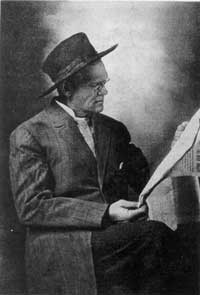
Aaron Johnson, Jr. photo reprinted from “Life Sketch of Aaron Johnson” Books I and II, courtesy of A. J. Johnson Publication Committee |
The first quarter of the year is rarely the best for hoofing it in southern Utah, with the onset of snowmelt in February creating deep and sometimes slippery mud that makes the going slow. In April, creeks and rivers begin swelling with the runoff and late in the month threaten to flood their banks when seasonal rains add their deluge.
It was that type of weather that dogged a group of pioneers sent from northern Utah in February 1876 to colonize the Sunset Crossing area across the southern border into Arizona. Much to most of their delight -- according to one member’s personal journal -- the attempt at settlement failed because of poor harvest potential and a river that went dry. By April, most of the families eagerly returned to homes in upstate Utah, at one point stalling three days before crossing the raging Colorado River.
Unbeknownst to Moab and other towns in southern Utah, the colonists’ failure was a fortunate twist of fate for theater-goers, since the journal writer, Aaron Johnson Jr. of Springville, later formed a traveling drama troupe that traveled the state and into Canada, entertaining culture-starved audiences over a period of 40 years.
In 1882, Aaron Johnson and his brothers had built a theater at Springville that attracted first-class acting companies and
justified $1,000 worth of stage sets painted by Henry C. Tryan of Chicago, Aaron’s daughter Claudia (Johnson) Whitney wrote in a historical account of the family. She wrote that J.M. Westwood (a family with descendants now living in Moab) was one of the “more noted” of the stable of actors, along with Aaron and Mose Johnson, C.W. Houtz, Lydia N. Johnson, Luella Matson, Eliza Johnson, and Lulu and Lily Boyer.
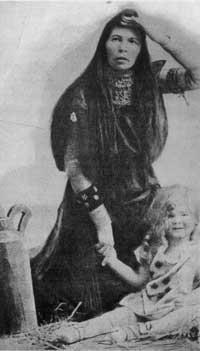
Aaron and Louisa M. Johnson’s son Bryan in role of Biblical Ishmael, child of Hagar (Louisa). photo reprinted from “Life Sketch of Aaron Johnson” Books I and II, courtesy of A.J. Johnson Publication Committee |
“The local troupe, members of S.S. Hamil’s elocution class, became almost as good as professionals, being great favorites at home and through the southern part of the state,” she wrote. “After completing the course in elocution, which was taught by Mr. Hamil, my father began his career as an elocutionist and actor.”
What started cozily in 1890 in Utah Valley as the “Johnson Brothers Dramatic Company” evolved into the Home Dramatic Company and regularly took to the road in three-seated spring wagons pulled by two white horses and laden with sets, equipment, costume trunks, and performers. Posters and flyers all over town preceded the troupe’s arrival, and in larger towns such as Price, the company would pack the house for two nights of plays.
In Moab’s Star Hall, a structure now listed on the National Register of Historic Places, the actors from Springville and Mapleton performed “East Lynne” in the impressive new “amusement hall” built in 1906. Other plays the company offered included “Uncle Tom’s Cabin,” “Above the Clouds,” “Out of His Sphere,” and “Two Orphans.”
“The people liked this kind of entertainment and most of the townspeople would attend, which was made profitable for the time spent to accomplish (the production),” Claudia Whitney wrote. She had some acting training and went along for one troupe tour in 1891. “My father was advance agent and he would leave…ahead of us with a one-horse buggy, arriving at the next town where he would put up posters and distribute bills and programs at the stores and other shops so the play would be well advertised.”
In the mid-’20s, Johnson moved his family to Altonah in the Uintah Basin area and over a six-year period became well-acquainted and popular with members of the Ute and Ouray Indian reservations, including Ute Chief George Goose and Chief Moroni, who turned down his request to be made a “chief” as well. In consolation, Chief Goose later selected the dramatist to lead the annual Ute Pageant and to stage the traditional Bear Dance and Sun Dance to standing-room-only houses to benefit the tribes.
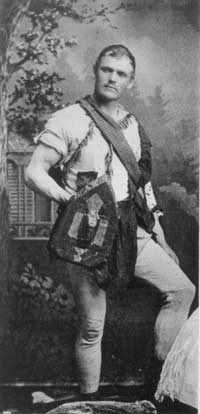
Troupe organizer and actor Aaron Johnson Jr. in stage costume. photo reprinted from “Life Sketch of Aaron Johnson” Books I and II, courtesy of A. J. Johnson Publication Committee |
The procession both days were colorfully depicted in Johnson’s memoirs and labeled “the most impressive parades I ever beheld -- 80 miles from a railroad!”
“There were 100 Utes, and 50 squaws in the gaudy parade; all mounted, mostly on pinto ponies. Then came the (LDS) bishopric, and most of the folks of the town, marching with heads erect, while the Indians beat their drums and the Altonah Brass Band never did so well. My duty,” Johnson clarified, “was to ride at the head of this mighty procession, seated in our single buggy (with) my riding companion, the aged Chief Eagle Tail. E. Tail was said to be more than 100 years old -- not ‘young.’”
Johnson continued: “The band opened with “Charge of the Light Brigade.” We charged, and in five minutes, the mounted squaws and Indians were riding ‘round and around the School House Square, and up and down the streets. Their jingling bells, and trinkets, mingled with war whoops, and the beating of the Indian drums, gave my horse the martial spirit, and endeavored to keep the lead, which she did.”
“The next day,” he wrote, “the Utes were there, only more of them. The squaw, Elisabeth Jane Douglas, seemed to be a queen of the parade, and appeared in full costume. A beautiful painted six-foot wand was in her hand. Her head covered with a costly feathered headdress; silver beads, costly brooches, beaded leggings, moccasins and fringes! Many squaws surrounded this queen, clad in rich harmonious colors, their long straight black hair hanging in neat braids, or about their shoulders, loose.”
Johnson rode a horse as parade marshal the second day and tried to maintain a moderate clip. “Then came the sight!” he wrote. “They rode thru (sic) town on a swift gallop, circled the School House singing, yelling, and laughing. More than 200 merry Ute Indians! I carried Old Glory on my horse and kept it waving, while the Indians and squaws sang and chanted as they rode.”
He described a double column of some 40 “first Americans” marching behind a Red Cross float carrying a man costumed as Uncle Sam. Next came 30 “Ute cowboys” and then 30 white cowboys; civilians on horses; a teacher and students -- “200 children in line, with banners and flags flying” -- followed by a long line of vehicles filled with Ute families and more Utes on foot bringing up the rear of the parade.
Within hours, the celebration was interrupted with an announcement onstage. It was a telegram from Europe, announcing the advance of America’s Army into France, signaling a pivotal point in World War II. This was no act, but it certainly was drama.. The assembly wildly cheered and the packed building burst with patriotic fervor, Johnson wrote.
“Chief Goose whispered to me: ‘Tell Uncle Sam we like his government, and want to be loyal to Uncle Sam, and we are sure Uncle Sam wants to be loyal to us.”
Editor’s Note: The author is a descendant of Aaron Johnson Jr., on her mother’s side; and a member of the Grand County Historical Preservation Commission.
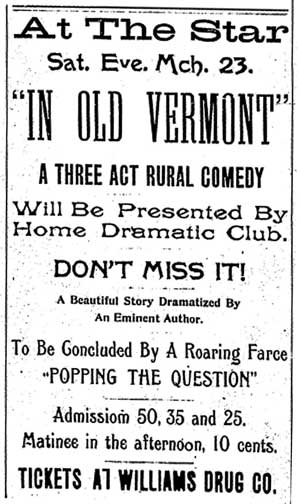
Poster announcing fall performance in Moab by the Home Dramatic Co. photo reprinted from The Canyon Legacy, courtesy of the Museum of Moab |
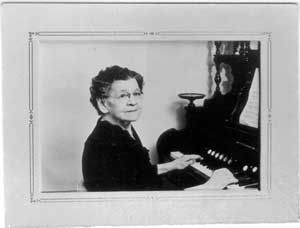
Late photo of Johnson family actress Claudia (Johnson) Whitney. Photo courtesy of Whitney Family collection. |
|




